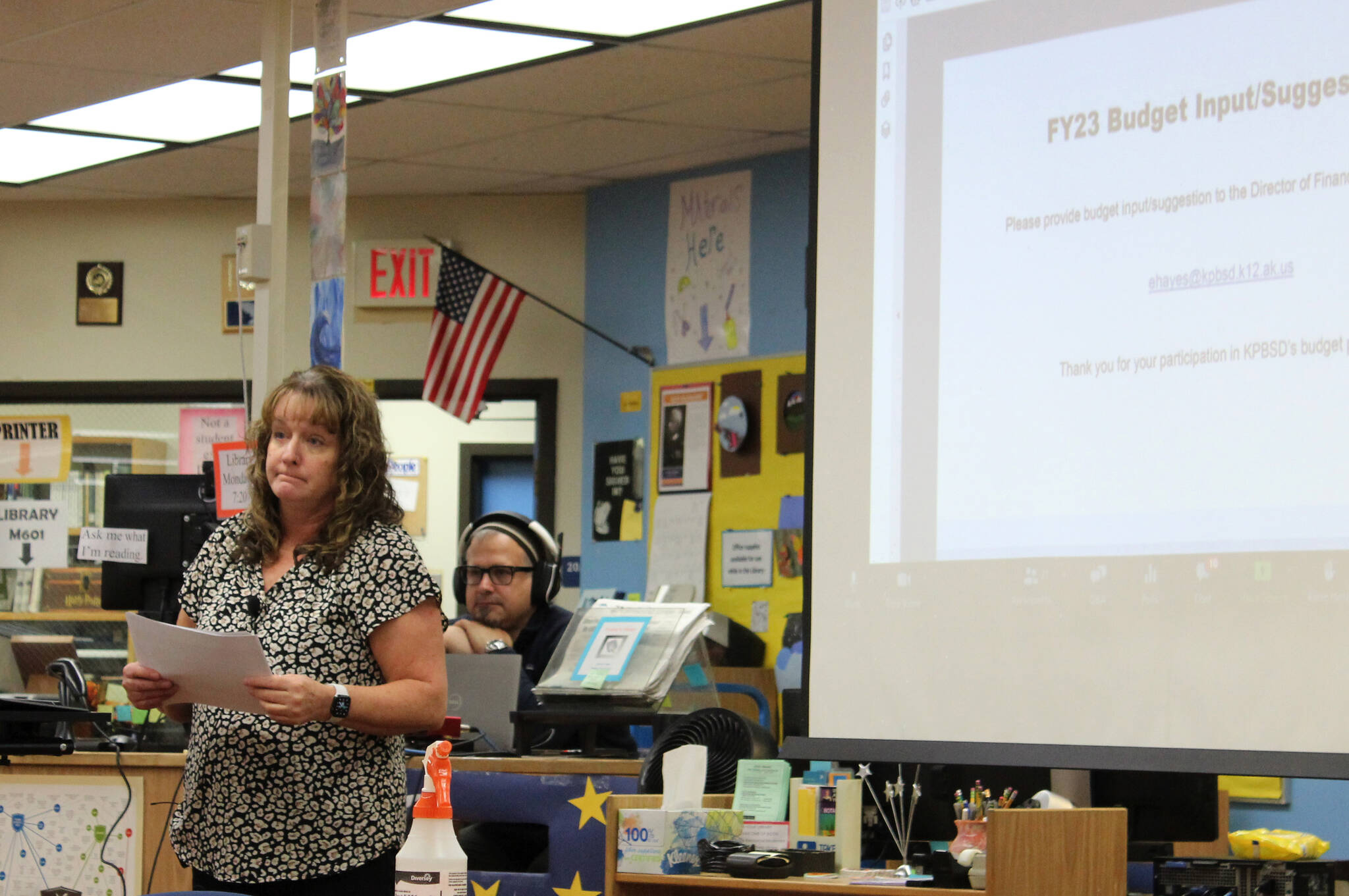Elizabeth Hayes spent some of her Thursday night explaining to a sparsely populated room at Soldotna High School how she builds the Kenai Peninsula Borough School District’s multi-million-dollar budget.
Hayes is the school district’s finance director, and Thursday’s budget meeting was the first of three public forums she’ll host in a tour around the Kenai Peninsula ahead of KPBSD’s next budget cycle.
Her 30-minute presentation at SoHi served as an all-in-one guide on how the school district’s budget is crafted, starting, Hayes said, with staff.
More than $100 million of the district’s roughly $134 million budget went to paying salaries and benefits for district staff. Historically, health care costs increase annually by between 8 and 10 percent and step increases in pay are built into the district’s salary structure.
On the flip slide, Hayes said she also calculates lapses in salaries and benefits, which has a negative effect on expenditures. Those lapses, for example, come from teachers who no longer “step up,” or from new hires who replace retired staff and are placed lower on the salary schedule.
Then she considers the cost of utilities at school buildings, which is estimated using the average cost for the past three years, and she looks at instructional and office needs based on projected enrollment. The number of the staff hired in the district corresponds directly to the number of students enrolled. If the population at Soldotna High School jumps, for example, Hayes may have to budget for additional staff at that school.
But where does the money come from? The bulk of the school district’s general fund revenue comes from three places: the State of Alaska, the Kenai Peninsula Borough and from “other” sources including things like federal e-rate and interest earnings.
The State of Alaska uses a formula to determine funding to school districts that is based on student enrollment, and called the foundation formula. The formula has several steps and multipliers, and determines the base student allocation, or BSA. Alaska’s per-pupil BSA has not changed since FY17 and is $5,930.
State statute also defines the minimum and maximum allowable funding range that the Kenai Peninsula Borough can contribute to K-12 education. For FY22, for example, that maximum amount was about $53 million. The borough is not obligated to give the school district the maximum contribution identified by the state, sometimes called funding to the cap.
KPBSD originally requested that the borough fund the district to maximum allowable during the FY22 budget process, while Borough Mayor Charlie Pierce and the borough assembly approved $45 million as a funding floor. The borough ultimately contributed around $50 million.
All of those avenues of funding, however, are in addition to three rounds of financial assistance the school district has received from the federal government throughout the COVID-19 pandemic.
Under the federal CARES Act passed in 2020, KPBSD received about $2.3 million in funding from the Elementary and Secondary School Emergency Relief, or ESSER, fund. Hayes said during Thursday’s presentation that all of the district’s initial ESSER funds have been expended.
The district received a second round of funding — ESSER II funds — in the amount of about $9 million under the Coronavirus Response and Relief Supplemental Appropriations, or CRRSA, Act. The district used those funds to save teaching positions that would have otherwise been eliminated.
“We wanted to keep our staff so the main focus of (ESSER II) funding was to not lay people off,” Hayes said.
Hayes said Thursday that, with ESSER II funds, KPBSD was able to retain dozens of staff across the district, including support and certified staff, elementary school counselors and student support staff, among others.
Some, however, are concerned about the long-term sustainability of the positions in light of the temporary nature of ESSER funds. Kenai Peninsula Education Association President Nathan Erfurth asked when the district plans to move the ESSER-funded positions back under the umbrella of the district’s general fund. Hayes said the district is waiting for the borough to improve financially.
“As the students come back and the borough(‘s) financial situation increases, we’re hopeful that gap between what the general fund can support narrows so we can move people off of those grant funds and get them back into the general fund,” Hayes said.
A third round of funding — ESSER III — was approved under the American Rescue Plan Act, or ARPA, signed into law by President Joe Biden earlier this year. Under ARPA, KPBSD will receive about $20 million, 20% of which — about $4 million — must be used to help students who fell behind academically during the pandemic catch up.
Up next for Hayes, however, is a winter revision of the district’s FY22 budget, which she said will begin in December. In the meantime, she said she shares concerns about what will happen once the district can no longer supplement its budget with the extensive COVID-19 federal funding currently available.
“We are watching that very closely to make sure that we don’t get to two years down the road and have a big cliff falling off,” Hayes said.
The presentation Hayes gave on Thursday is one of three preliminary FY23 budget talks she’ll host on the peninsula this month. She’ll be at the Homer High School library on Oct. 19 at 6 p.m. and at the Seward High School library on Oct. 20 at 6 p.m. Thursday’s meeting was the only one to offer remote participation, and can be viewed in full on the school district’s media page.
More information about KPBSD’s budget process can be found on the district’s finance page.
Reach reporter Ashlyn O’Hara at ashlyn.ohara@peninsulaclarion.com.

